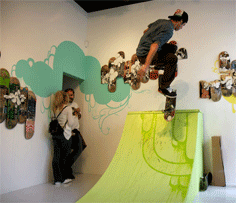The Cubans are behind.
Given the shortage of equipment, skills training from outside the island and lack of public space, it is no wonder that Cuban skaters are not keeping up with their counterparts abroad.
The Havana skate community is estimated to hover around 400 to 500. There is one skate park on the entire island; most skating is done freestyle, or on makeshift installations in public spaces. There are no skate shops in Cuba, although there’s a rumor that some of the island’s surf shops do sell skateboards. Still, at around $40 a pop, skateboards can represent three to four months of wages for the average Cuban.
Puerto Rican mural artist Sofia Maldonado is joining a growing effort to bridge the divide between the Cuban skating community and the rest of the world. Maldonado, 24, launched her most recent collection, Tropical Storm in May 2008 at the Magnan Emrich gallery in New York shortly after receiving her Masters in Fine Arts from the Pratt Institute in Brooklyn, New York. She launched the outline for her next project Skate My Patria, last weekend in New York at PINTA; the Modern and Contemporary Latin American Art Fair.
Through Skate My Patria, Maldonado plans to deliver 200 boards and skate equipment to Cuban skaters when she travels to the island on an artist visa this March. But this is not a charity trip—”I’m not going to just give [the boards] away.  I’m not Santa Claus,” says Maldonado. “I want to get feedback, I want information on [Cuba’s skate] culture.” Maldonado will be traveling with a pro-skater from Puerto Rico and a cameraman. She plans on conducting skate clinics and documenting the trip for a future exhibition.
I’m not Santa Claus,” says Maldonado. “I want to get feedback, I want information on [Cuba’s skate] culture.” Maldonado will be traveling with a pro-skater from Puerto Rico and a cameraman. She plans on conducting skate clinics and documenting the trip for a future exhibition.
The clinics, she hopes, will be especially helpful as “Cubans are behind in tricks.” The reason for this being, not only a lack of skate parks, but also an unwillingness to risk breaking the boards—a common casualty among pro-skaters.
To fund the project, Maldonado is raising money by auctioning her art. At PINTA’s silent auction, she sold a canvass painting (a collaborative effort between herself, other artists and fellow skaters) for $1,100. She will be auctioning other items at Miami’s Basel art festival in December, and is currently selling a line of bags at skate shops in New York.
Maldonado is not the first to embark on such a project. She is joining an already vibrant international community of skaters who have traveled to Cuba and documented what one artist calls “The Cuban Skateboarding Crisis.”
Maldonado, who is half-Cuban, says her project aims to “re-establish links between the sister islands” of Puerto Rico and Cuba. She was drawn to Cuba, in part as a reaction against the commercial nature of skating in the U.S. “Skate culture in the U.S. is very capitalistic and all about branding and sponsorship,” she says, adding that many young skaters in the U.S. are as preoccupied with what company would sponsor them as with skating as a sport. “There’s none of that in Cuba,” she said. “There, people skate for the love of skating.”
Much of her art has centered around skating and the culture surrounding it, but for Maldonado, skating is a hobby, an “escape” more than anything. “It’s very liberating to skate and let the street take you. I imagine skating in Cuba is the same. It seems like they could use that escape.”



